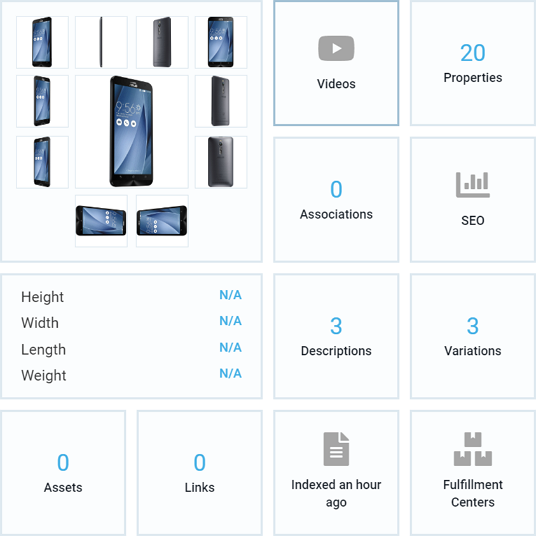Widgets¶
A widget is a relatively simple and intuitive web UI component within Virto Commerce Platform. It is basically a transient or auxiliary tile, which:
- Occupies just a fraction of a blade
- Provides useful information
- Usually enables opening another blade with extra information and functions
- Is reusable and can be added to as many blades (widget containers) as you want
A widget container is a placeholder control for widgets, which:
- Displays widgets in a rectangular area
- Accepts options like size, widget column and row count, etc.
- Allows the user to manage widget position within designated area
A widget service is a platform level engine for registering widgets and distributing them to the appropriate widget containers.
Here is how we use widgets out of the box in our Catalog module:

Widget Container¶
You can implement widget containes as the vaWidgetContainer Angular.js directive. We use angular-gridster under the hood, which means our containers support and accept angular-gridster options.
<va-widget-container group="itemDetail" blade="blade" gridster-opts="{columns: 6, minRows: 4}"></va-widget-container>
| Parameter | Description |
|---|---|
| group | Widget group ID. Only widgets from this group will be displayed. The value should be in line with the context of the container, e.g. itemDetail, and be unique among all widget containers. |
| blade | Reference to parent blade. Sent to each widget inside the container. |
| gridster-opts | Angular-gridster options (optional value). |
Registering Widget¶
You can register widgets through the Platform-level factory, which means any module can register new widgets to any widget container:
- Reference
platformWebApp.widgetService(aswidgetService) in your module'srunmethod. - Create widget option definition and call
widgetService.registerWidget.
var variationWidget = {
controller: 'virtoCommerce.catalogModule.itemVariationWidgetController',
size: [2, 1],
isVisible: function (blade) { return !blade.isNew && blade.controller === 'virtoCommerce.catalogModule.itemDetailController'; },
template: 'Modules/$(VirtoCommerce.Catalog)/Scripts/widgets/itemVariationWidget.tpl.html'
};
widgetService.registerWidget(variationWidget, 'itemDetail');
WidgetService.registerWidget parameters:
| Parameter | Description |
|---|---|
| widget | Widget options |
| containerName | Widget group ID that will be added to the widget container having the same group. |
Widget options:
| Option | Description |
|---|---|
| controller | An Angular.js controller for the widget. Instantiated only on widget rendering, which means parent blade is accessible in the $scope.blade variable. |
| size | Widget dimensions: [number of columns, number of rows]. An optional parameter with the default value at [1,1]. |
| isVisible | Toggles widget visibility (a widget get invisible if this option is set to false). Set to true by default. |
| template | Template URL for the widget. Check our Style Guide for details. |
Widget Visibility and Permissions¶
Widget visibility is controlled by defining the isVisible method in widget registration options. There are at least two use cases when limiting visibility is required:
- The widget is appropriate only in some scenarios, e.g., you need to hide order widget while creating a new item or hide inventory widget for a digital product.
- Access to the widget is restricted by security permission, as in the sample piece of code below: